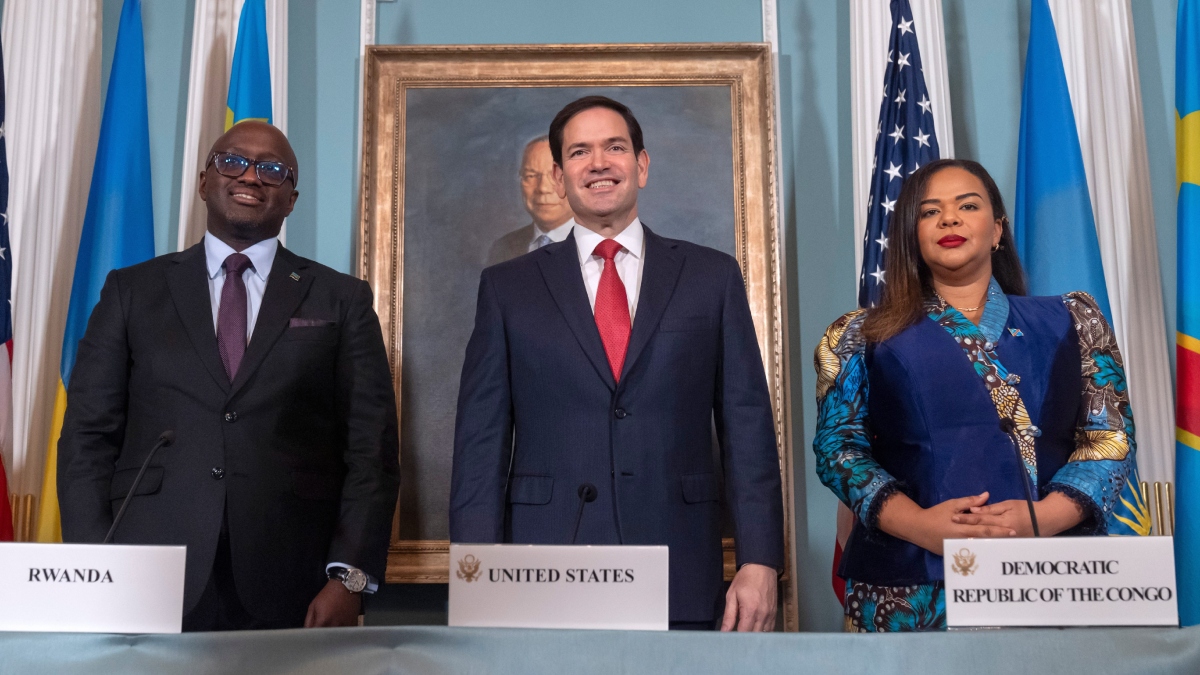DR Congo-Rwanda peace deal explained: Will Qatar, US efforts end the world's deadliest humanitarian crisis?
 Secretary of State Marco Rubio (C) stands with Rwanda's Foreign Minister Olivier Nduhungirehe (L) and Democratic Republic of the Congo's Foreign Minister Therese Kayikwamba Wagner (R) after signing a peace agreement at the State Department | AP
Secretary of State Marco Rubio (C) stands with Rwanda's Foreign Minister Olivier Nduhungirehe (L) and Democratic Republic of the Congo's Foreign Minister Therese Kayikwamba Wagner (R) after signing a peace agreement at the State Department | AP
The Democratic Republic of Congo and Rwanda signed a United States-brokered peace agreement on Friday. The deal signed by the countries’ foreign ministers at the State Department in Washington DC would end the year-long fighting between the two neighbours.
While the treaty looks promising, analysts don't see the conflict ending that quickly since many militia groups are yet to agree to its terms and lay down weapons.
What was the cause of the conflict between the DRC and Rwanda?
The DRC has been subject to violent conflicts due to its mineral-rich lands for more than 30 years. Armed groups within the country have competed with the central government for control over such resources.
One of the most prominent of these armed groups is the Rwanda-backed M23 rebel group. The M23 rebels advanced and captured several border regions, including Goma—a strategic area rich in minerals worth trillions of dollars. Their offensive left nearly seven million people displaced and resulted in numerous deaths. M23 has also voiced intentions to expand its territorial control, with the ultimate aim of capturing Kinshasa, the capital of the Democratic Republic of the Congo.
The M23 is only one of 100 armed factions in eastern Congo. The group is primarily composed of ethnic Tutsi who had led an insurgency against the Congolese government in 2012. After lying low for a decade it resurfaced in 2022 with its leaders claiming that their fight has nothing to do with natural resources. Speaking to the Associated Press in February 2023, Corneille Nangaa, head of the rebel coalition a 'Congo River Alliance', said that “Our objective is Congo, we are fighting for Congo. We are not fighting for minerals, we are not fighting for anything (else),”
The roots of the conflict trace back to the 1994 Rwandan genocide, in which Hutu militias killed around 500,000 to 800,000 people—including Tutsis, moderate Hutus, and members of the indigenous Twa community. In the aftermath, around two million Hutus fled to neighbouring Congo, fearing retaliation from the Tutsi-led Rwandan Patriotic Front. Since then, ethnic tensions between the groups have rocked DRC.
Rwandan authorities have accused the Congolese army of protecting and integrating the Hutus who committed genocide in the country and fled. They allege that the militias formed by the Hutus are a threat to Rwanda’s Tutsis.
Researchers, the DRC, United States and UN experts have said that the M23 is an attempt by Rwanda to gain economic control over eastern Congo. UN experts in a report said that Rwanda was “fraudulently” benefiting from minerals mined from areas occupied by the M23. Rwanda has continued to deny involvement and continues to say that they are only acting in self defense against the Congo army and the Hutu militias, jointly, the Democratic Forces for the Liberation of Rwanda (FDLR).
The current state of the conflict
7,000 people have been killed one million people have been displaced just since the beginning of this year.
The conflict has killed 6 million people since it began in famines, attacks, and disease outbreaks. 7.8 million have been displaced internally in the country. UN reports have called the situation in the DRC as the largest and deadliest humanitarian crisis in the world. Another report said that about 28 million people in the country suffer from food insecurity.
How will the peace deal solve the conflict?
The efforts for the peace deals were made by both the United states and Qatar. The M23 were not part of the negotiations that happened on Friday. However, they did participate in a separate negotiation that was made by Qatar and declared a truce with Congo. The peace deal accord contains a number of provisions on respect for territory and prohibition of hostilities including disarmament, disengagement and a conditional integration of then the non state armed groups. The provisions also include provisions for the facilitation of the return of refugees and displaced populations and humanitarian access.
Donald Trump had told reporters on Friday that the accord allows the US to get a lot of mineral rights from Congo. The agreement will de-risk mineral supply chains and establish value chains that link both countries with the US according to Reuters.
World